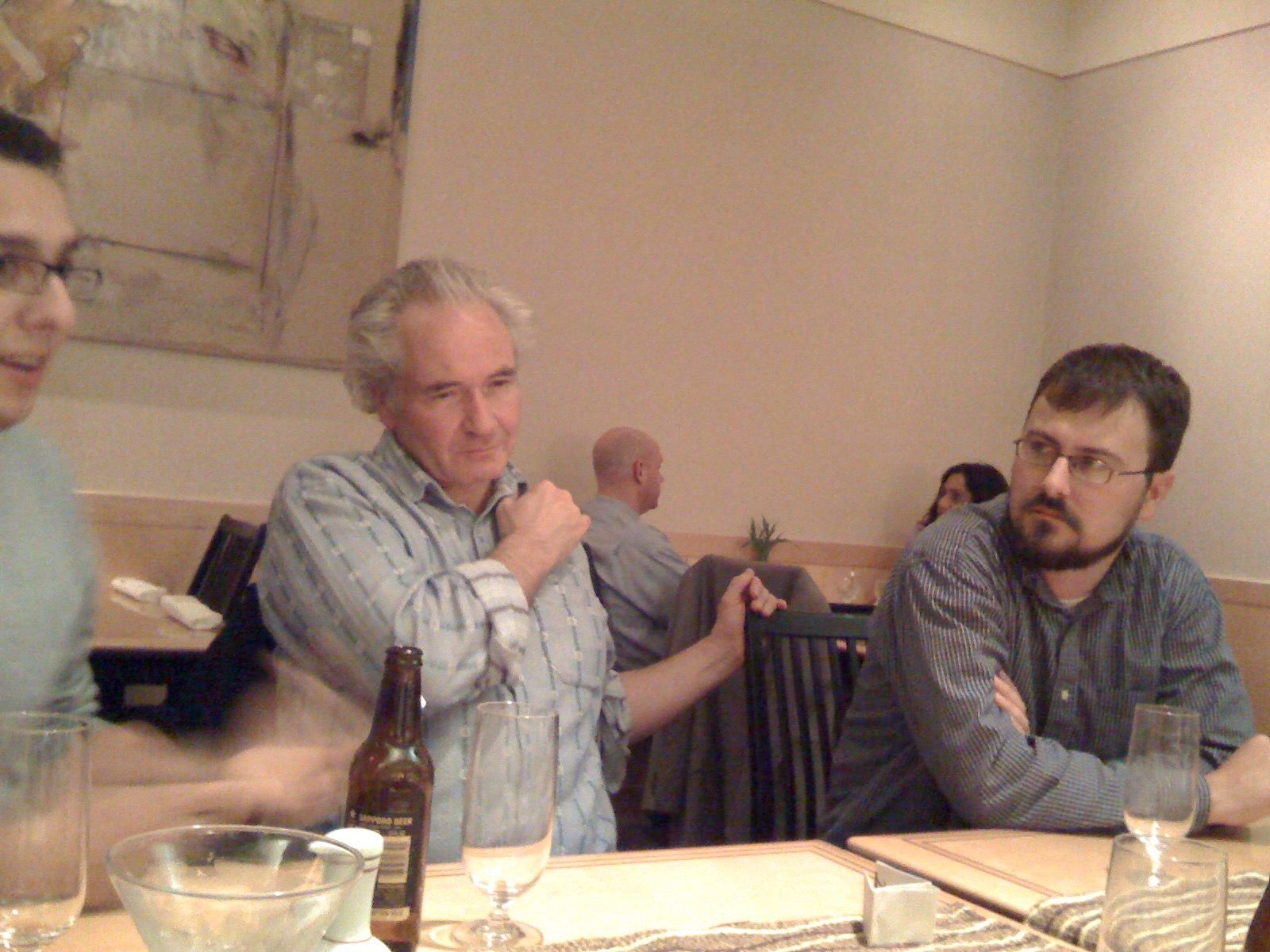I’m Waiting for the EBITDA: Visiting the ZDE Office in NYC
It's May 2008 and due diligence kicks off at Ziff Davis Enterprise headquarters, on 28th St in midtown Manhattan. Before that, I meet my ReadWriteWeb colleague Bernard Lunn for the first time.

The due-diligence meetings with Ziff Davis Enterprise would start at midday on Monday. But first, I had arranged to meet Bernard Lunn, a freelance ReadWriteWeb writer and now my business advisor, who was based somewhere in greater New York.
Around 9:00 a.m. I finally put a face to the name, when Bernard met me in the lobby of Hotel Chandler. He was a guy in his fifties, clean-shaven and with a high forehead. His grey hair was a bit longer than it should’ve been and therefore unkempt, despite his obvious attempts to comb it back that morning. He was dressed in a mix of casual and business attire, with a buttoned shirt and sweater over blue jeans. When he greeted me, his accent was vaguely upper-class English—but one that had been diluted, perhaps after years of living abroad. The overall impression was of a professor of history who had gone into Manhattan to visit some bookshops.
It turned out, that wasn’t far off. Over coffee, Bernard said that he’d studied history at Oxford University in England. His father had worked at MI6, the UK’s Secret Intelligence Service, and as a boy he’d lived an itinerant lifestyle and was sent to boarding school in Britain. As he later relayed on his blog, “Wherever we lived, I always went to the Swiss Alps for 4 weeks every winter as my father was a fanatic skier.” In his early career, he said, he’d been typecast as “the shy academic [who] had become a salesman.” He later worked in a variety of IT sales roles and continued to travel extensively, including a job during the 1990s where he’d been “asked to run the Asian operations” of some kind of banking software company.

I was never fully clear on what type of business software Bernard had spent his career to this date in, but it soon became apparent that it was quite different from the consumer web industry that RWW covered. Also, though he’d been feeding me useful information about the way CMP and ZDE did business, I discovered that morning that he didn’t actually have experience in the IT media industry. Despite all this, he was a self-described salesman, and that was undeniably helpful to me at this point. He seemed to have the gift of finding the right buttons to push when negotiating business deals, something that I was a complete n00b at. So we hit it off, and at the café he gave me more useful tips about how to deal with ZDE and Insight Partners.
One thing we discussed that morning was how to approach RWW’s sales targets. I needed to have control over sales for at least the next two years because of the earn-out. Bernard said I should have a point of view on this going into today’s meetings. In his view, the options were twofold: go all-in with FM Publishing (which currently sold roughly half of RWW’s advertising) or hire a RWW “sales guy” and use the ZDE sales team as a lead generator. I pointed out that I currently sold the other half of RWW’s ads myself, to the sponsors. Since FM had already proven it couldn’t manage my sponsors, maybe I’d need to pursue both options.
In any case, I needed to get more clarity on what support ZDE would offer regarding sales. Because RWW was currently a New Zealand business, there were international tax implications to hiring people. That was a big part of why I wanted to sell RWW—to clean up its legal structure and make it a purely US business, or a part of one. But I wasn’t yet clear on how ZDE planned to incorporate RWW into its current structure, which was complicated by the fact it was owned by a private equity firm.
After coffee with Bernard, I went back to my hotel room to mull over my tactics going into the first in-person ZDE meeting. I knew hardly anything about how the IT media business worked here on the East Coast, and I was also nervous about meeting the big-city financial analysts from Insight Partners. I wished Bernard could attend the first meeting with me, as I could use a wingman who had business nous. But I knew I was on my own from here on out.
Visiting ZDE
The ZDE office was located at 28 East 28th Street, in the Midtown South area of Manhattan. I’d quickly learned that the best way to get to an address in New York City was to note the connecting streets, and I was amused to see that one of them was Lexington Avenue. I knew this name from “I’m Waiting for the Man,” a Velvet Underground song about buying heroin at the intersection of Lexington and 125—way uptown. ZDE was a block from Lexington, but downtown. And judging by all the grey and brown high-rise buildings, there wasn’t much rock ’n’ roll romanticism at this location.
I entered the nondescript fifteen-story building that ZDE occupied and asked for Mike Azzara at reception. He came down to greet me, and we rode the elevator to ZDE’s office, which was on one of the middle floors. If I was expecting a modern office like Yahoo in Silicon Valley (or, for that matter, ZDNet in San Francisco), I was disappointed. ZDE’s office looked like it was from the 1980s, with its beige walls and tatty brown carpet.
As we walked into a conference room, a tall young guy—smiling from ear to ear—reached out to shake my hand. It was Kobi Levy, the Insight Partners associate who had started the deal process. He looked to be in his late twenties or early thirties and was stylishly dressed in a suit. He was a handsome, clean-shaven guy with short-cropped dark hair, and he looked eager to get down to business. The other person in the room was Steve Weitzner, ZDE’s chairman and CEO. He was an amiable-looking man in his mid-to-late fifties, I guessed. He had a full head of grey hair and a matching grey beard, and wore a light brown button-down shirt and camel suit.
A lunch was brought into the room as we chitchatted about my long plane journey and my first impressions of the Big Apple. Soon enough we took seats at the conference table and talked through how RWW would be integrated into ZDE, including—crucially—how the blog would maintain its autonomy. I was told that we would become a wholly owned subsidiary, but ZDE would take some of the business burden off my shoulders—accounting, sales, HR, and so on.
We made some tentative plans around the working relationship, establishing that I would report to Mike, but I would continue to run the day-to-day business of RWW. We didn’t make any specific plans around accounting or sales, but the general agreement was that ZDE would provide resources for this, which would be internally charged to RWW’s expenses. I would manage the RWW budget, which Steve and Mike assured me would give me control over the earn-out targets. I didn’t fully understand how that would work, since I had never run a wholly owned subsidiary inside of a larger company. But in the interest of moving the discussions forward, I accepted that ZDE would put in the appropriate structure.
After the formal discussions, Steve and Mike took me out to dinner. I was pleased to have the opportunity to get to know Steve more. He seemed genuine about admiring what RWW had achieved so far in its young life, and he clearly wanted some of our blog mojo to be injected into ZDE. Over dinner he told me that he saw RWW as one of the best examples of where B2B journalism must rapidly evolve to, adding that traditional B2B media companies—like ZDE—needed to adapt quickly. Also, both he and Mike admired my recent redesign of RWW. The new design captured the blogger spirit, Steve told me, but placed it in a context that was more expansive than a typical blog—it was more like a media company approach.
I was thrilled to hear all this, and I felt like Steve understood both what RWW was at present and what it could become with a bit more structure in place. I didn’t quite warm to Mike in the same way, despite this being our second dinner together. Perhaps it would take more time to get us on the same wavelength. But, ultimately, Steve was the guy in charge, and so having his support was vitally important to me.
The only jarring note of the day came right at the end, when we were finishing up dinner. Tuesday’s due diligence would be focused on RWW’s finances. I think Steve wanted to give me a friendly warning that discussing financial statements with a private equity firm would not be straightforward. He noted that the revenue I’d entered into a spreadsheet for February and March was slightly below what I’d previously projected, which could result in Insight pushing for a decrease in the final sale price. Insight, he explained, would want to close with the exact same EBITDA multiple as in the original projections.
EBITDA was an accounting acronym I’d quickly come up to speed with once I’d begun talking to both CMP and ZDE; it meant “earnings before interest, taxes, depreciation, and amortization.” That is, earnings after expenses but before tax and other accounting adjustments. The “multiple” was just that, the EBITDA figure times a specified number—in our case, twelve. So if EBITDA for the 2008 tax year, which ended March 31, was slightly less than what I’d projected, then multiplying that revised figure by twelve would result in a reduced sale price.
Perhaps noticing my shocked expression, Steve quickly followed up with a few suggestions to adjust the spreadsheet so that it more closely matched the original projections—for example, removing the redesign costs, which should be capitalized. This was the kind of practical accounting knowledge that I lacked, since I didn’t have a background in business. I also didn’t have a COO or other business partner to lean on (although this wasn’t Bernard’s area of expertise, either). So I felt a bit vulnerable now, knowing that the bean counters at Insight Partners were looking for financial gotchas to spring on me. However, I could also see that Steve really wanted to get this deal done and was trying to help me.
After the dinner I went back to my hotel to look again at the spreadsheets. I made the adjustments Steve had recommended and sent it off to ZDE and Insight. I emailed Bernard, too, and he wrote back with his moral support. We arranged to meet again at nine the next morning for a pep talk before I faced off with the financial analysts from Insight.
Lead image: photo taken in August 2008 at the 28th Street station, on the Lexington Avenue Line; by jpellgen on Flickr.
This post is part of my serialized book, Bubble Blog: From Outsider to Insider in Silicon Valley's Web 2.0 Revolution. View table of contents.
Next up: 033. Alien in New York: ReadWriteWeb & the American Dream
Buy the Book
My Web 2.0 memoir, Bubble Blog: From Outsider to Insider in Silicon Valley's Web 2.0 Revolution, is now available to purchase:
- Paperback, US$19.99: Amazon; Bookshop.org
- eBook, US$9.99: Amazon Kindle Store; Apple Books; Google Play
Or search for "Bubble Blog MacManus" on your local online bookstore.